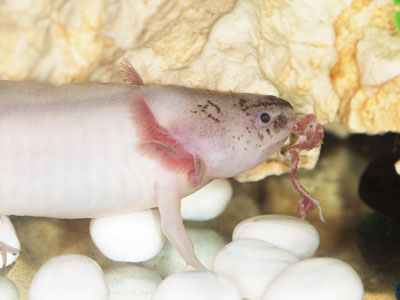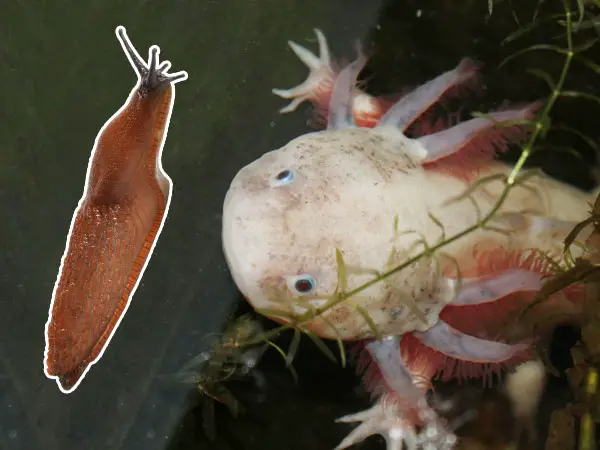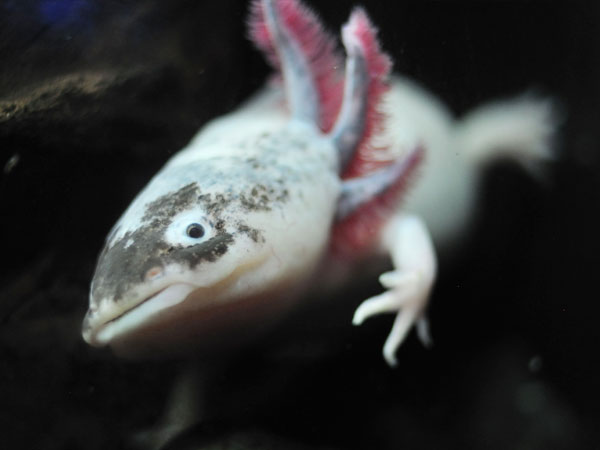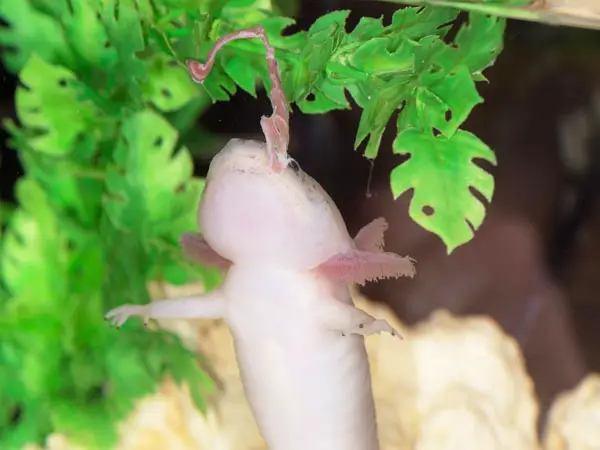
New to axolotls? Want to offer them the best foods? Don’t know how often you should be feeding them? Or how you should be feeding them?
This guide on feeding axolotls will get you up to speed with the diet and foods that work best for axolotls.
I will focus on giving you as many info possible on what and how you should feed baby axolotls and adult axolotls and describe the foods available for axolotls in the wild.
I’ll preface things by saying that axolotls are carnivores. They eat a meat-based diet in the wild, so you’ll need to feed them meat-based foods in captivity too.
What Do Axolotls Eat in the Wild?
Native to the canals and waters of the Xochimilco region in Mexico, axolotls feed on whatever small animals are available to them in their natural habitat.
Axolotls feast on insects, worms, slugs, small crustaceans, crickets, mosquito larvae, smaller salamanders, frog tadpole, and even smaller fish they can swallow.
They operative word here is swallow, because axolotls do indeed swallow their food. Axolotls feed by opening their mouths wide and sucking in water along with their prey.
Because the same types of protein-rich foods are available for aquarists raising axolotls in captivity, it’s not difficult to meet their nutritional needs that are raised in a home aquarium.
Despite having a set of rudimentary teeth, axolotls don’t use them when feeding, they only use it to snap down on their food, rather than chew food.
If you’re curious about their teeth, you can put your hands into the tank next time you’re feeding them to see how they latch onto your finger. Don’t worry, their teeth aren’t sharp enough to pierce the human skin.
For axolotls to be able to swallow their food whole, food needs to be small enough not to cause trouble on its way down their gastrointestinal tract.
Food that is too large can get impacted, that is, cause bowel obstruction, which can be fatal for axolotls if they don’t manage to expel the cause of impaction.
Impaction can also happen if axolotls ingest pebbles or gravel. This is why aquarists avoid using these as a substrate and choose sand instead, which is not harmful for adult axolotls (although it can cause problems in juvenile axolotls that are smaller than 5 inches).
I’ve seen axolotls thrive both in aquariums without a substrate and in aquariums with a substrate, although I prefer adding sand because it usually makes axolotls feel more comfortable when their have a substrate, plus their traction is much better when there’s a substrate in the aquarium.
Axolotls don’t eat plants, but if you have floating plants in the aquarium or shrubbery, they may snap down on them just because of the motion these plants make in the water.
So, if you have plants in the aquarium, make sure they’re sturdy ones like java fern. Otherwise, if you notice axolotls actively eating plants, it may be because they’re very hungry.
Axolotls don’t require plants in their diets nor in their tanks, but they do require hiding spaces like caves, terracotta pots and PVC pipes. Make sure to avoid anything with sharp edges.
What to Feed Axolotls in Captivity
Captive raised axolotls eat various meaty foods including earthworms (nightcrawlers), black/white worms, live daphnia, live brine shrimp, freeze dried or frozen foods (e.g. bloodworms, brine shrimp), salmon pellets and other foods that they would otherwise eat in the wild.
Some food options are better than others, but each have their pros and cons that you should know about, especially when it comes to health issues, diseases, and water chemistry.
Here’s a quick rundown on some foods that axolotls enjoy:
Earthworms
When it comes to nutritious axolotl food, earthworms are the go-to food for many axolotl owners. That’s because earthworms are also among the favorites of axolotls and for good reason — earthworms are a nutritious food that meets their dietary requirements.
Earthworms are a staple food for adult axolotls, but even for them, earthworms can be too big to swallow, so it’s best if you cut up earthworms into smaller pieces.
Another potential issue with earthworms is that they require washing before you feed them to your axolotl to remove dirt and soil.
I recommend sourcing earthworms from organic gardens where no pesticides or herbicides are used or culture your own for quick availability and more control over quality.
Live Daphnia
These tiny creatures best serve the nutritional needs of baby axolotls since live daphnia may be too small for adults to notice and will not meet the nutritional needs of an adult axolotl.
Baby axolotls, on the other hand, love these, so don’t hesitate to include them into their diet.
As with any live food, there is a risk of infecting your axolotl with whatever potential diseases or parasites live foods carry.
The solution to this is to get your daphnia from a reputable source or make your own cultures at home, which you can do with the help of a starter kit.
Daphnia are an affordable food source, easily accessible and can even be useful for your tank as they can eat some unwanted bacteria.
Live Brine Shrimp
Freshly hatched brine shrimp is best for baby axolotls. They can be cultured more easily compared to daphnia and they’re affordable and an easily available food option.
Live brine shrimp can also carry diseases, so be careful where you get it from if you’re not making your own at home.
A downside of brine shrimp is that they die off quickly in freshwater, which can lead to disturbances in the water chemistry if they’re left to rot in the tank.
Black or White Worms
If you’re looking for an alternative to earthworms, black/white worms are a good option. They’re nutritious, healthy and easy to buy or to culture on your own.
A downside of these worms is that any leftovers can mess up your tank chemistry if they’re not cleaned fast enough. They’re suitable for both adult and juvenile axolotls.
Other Foods
There are a couple of other foods that can be part of your axolotl’s diet. For example, ghost shrimp can be a good occasional snack.
Frozen bloodworms may lack the nutritional punch of live foods, but axolotls seem to enjoy these very much too. The only downside is that they’re a messy food, so be mindful of tank cleanliness when feeding these to axolotls.
If live brine shrimp cultures are not readily available, frozen options can work as well, but these too are a bit messy, so be prepared for extra cleaning activities.
Another food option that I would recommend are salmon pellets, but make sure to get the soft sinking ones.
These may contain added chemicals that might not be good for axolotls, so make sure you read the label first to see if they’re 100% natural.
How to Feed Axolotls?
As I mentioned, axolotls have shallow teeth that aren’t suitable for chewing or tearing up food. They can use their teeth to grip down on food and suck smaller creatures in with a swoop.
If you’re feeding your axolotls earthworms, for example, it’s best if you cut the earthworms into smaller pieces, so your axolotls can easily swallow them.
Even food that is too small can be a problem if the food gets stuck into their gills. But more often than not, choking on food that is too large is a bigger problem you must address.
Having long tweezers can help you grab a biteful of live foods without creating a mess, and offering it to your axolotl. Make sure the tweezers don’t have any sharp edges that could injure your axolotl.
Another useful feeding tool is a turkey baster, which you can use to pick up leftover food from the aquarium.
You should always remove leftovers because as soon as they start breaking down or rotting, they can cause ammonia spikes that are dangerous for the health of your axies.
Having a slightly larger dish that your axies can hover over is also useful if you want to avoid creating a mess in the tank.
Use a turkey baster to pick up the food you’re planning on giving to your axolotls and place the food into their dish.
Once your axolotl has finished eating, you can remove the leftover food with the turkey baster. While this isn’t a 100% mess-proof method, it can still go a long way in cleaning up leftover food that could cause ammonia spikes if left in the tank.
What to Feed Baby Axolotls
Adult axolotls rely mostly on their sense of smell to capture their food and don’t have very good eyesight. Baby axolotls, however, require live foods because their sense of smell isn’t strong yet and they rely on spotting movement to identify food sources.
Therefore, baby axolotls should be fed with live foods exclusively since they won’t be interested in foods that aren’t moving or wiggling.
Staple foods for baby axolotls include live daphnia, baby brine shrimp and microworms, chopped blackworms, which continue to wiggle even after they’ve been cut.
Newly hatched axolotls will still have their egg yolks, which will give them sustenance for a day or so, but after that you should start feeding them because they’ll be ready to take on food and can’t go long without food.
Live daphnia and newly hatched baby brine shrimp are the best choices since they’re nutritious and small enough for them to eat.
Once they’re large enough to actively hunt for food (usually when they develop their legs), you can start adding some of the foods you’d give adult axolotls just make sure you cut everything in pieces small enough to be swallowed whole.
Baby axolotls require more frequent feedings than adult axolotls, so make sure you feed juvenile axolotls more often.
How Often Should You Feed Your Axolotl?
Baby axolotls are still developing and growing quite rapidly, which means they require a lot of nutrients to grow and they have a faster metabolism compared to adult axolotls.
I recommend feeding baby axolotls every day, once or twice a day. Adult axolotls, on the other hand, should be fed once per day only 2-3 times a week, because they take 2-3 days to digest their food.
Adult axolotls can go weeks without food, and while I don’t recommend testing this, I also don’t recommend daily feedings, which can cause indigestion, trapped gas, constipation and impaction.
Not to mention the increased waste production that overfeeding causes in the aquarium, which affects the health of your axolotl on a different level.
A Note on Axolotl Food Safety
It’s very important to ensure that the food you’re introducing into the tank is disease-free. Live foods can carry parasites and protozoa known to cause infection in axolotls. Live plants are another source of such parasites.
While axolotls thrive on a live food diet, you may substitute live foods for freeze-dried food, but be advised that these don’t pack the same nutritional punch as live foods do.
To avoid causing food-borne illnesses in your axolotls, you can source their food from growers that culture these foods in organic gardens (pesticide-free) or fish-free waters.
Alternatively, home cultivation kits make it easy for you to cultivate some of these foods (e.g. brine shrimp) at home.
Conclusion
Axolotls are not picky eaters, but they do require nutritious foods to stay healthy. While live foods are by far the best food you can get them, make sure their food is safe.
Also, on the principle of less is more, don’t overfeed axolotls. Axolotls usually seem very eager to accept their food and can trick you into offering them too much of a good thing.
Whether you’re feeding them live foods, frozen foods, or sinking pellets, make sure to remove leftovers to avoid water chemistry troubles. This is a rookie mistake that beginner keepers often make.
I hope this guide has answered your questions about feeding axolotls and you can use it as your go-to axolotl feeding guide.





I recently got 2 axolotyls and have been muddling along taking snippets from various websites. Yours is the 1st one I’ve come across that has all the information set out clearly with do’s and don’ts. Thank-you.
Hey Liz! Thank you for your feedback! I try my best share my experience with others.
By baby axolotl how young do you mean? Mine are about 3-4 months I would say by looking at them(3-ish inches) would they fall into the feed daily category,every few days or somewhere inbetween.Right now I’m doing every other day with a mix of blood worms and soft pellets.Is that too often or not enough?Thanks!
In my opinion it is enough to feed them every other day. Few weeks old axolotls should eat every day, but a 4 months axolotl will get along with eating every other day, especially if you feed them well.
Can axolotls also die because of too much food?
Great, helpfull site BTW
Just like with fish, overfeeding can also cause problems with axolotls, so better feed less food, than too much!
I have tried Bloodworms (frozen) and the axolotl doesn’t seem to be interested in them. we have had it about a week and it is about 4-4.5 inches long roughly. Not sure how to get it to eat at this point and how long it may take to want to eat after being shipped and subjected to that stress
I got my axolotl yesterday, and he is not eating and barley moving. Is that normal?
Hi I have 2 axolotl one is about 9 inch and the other 6 inch can I put them together